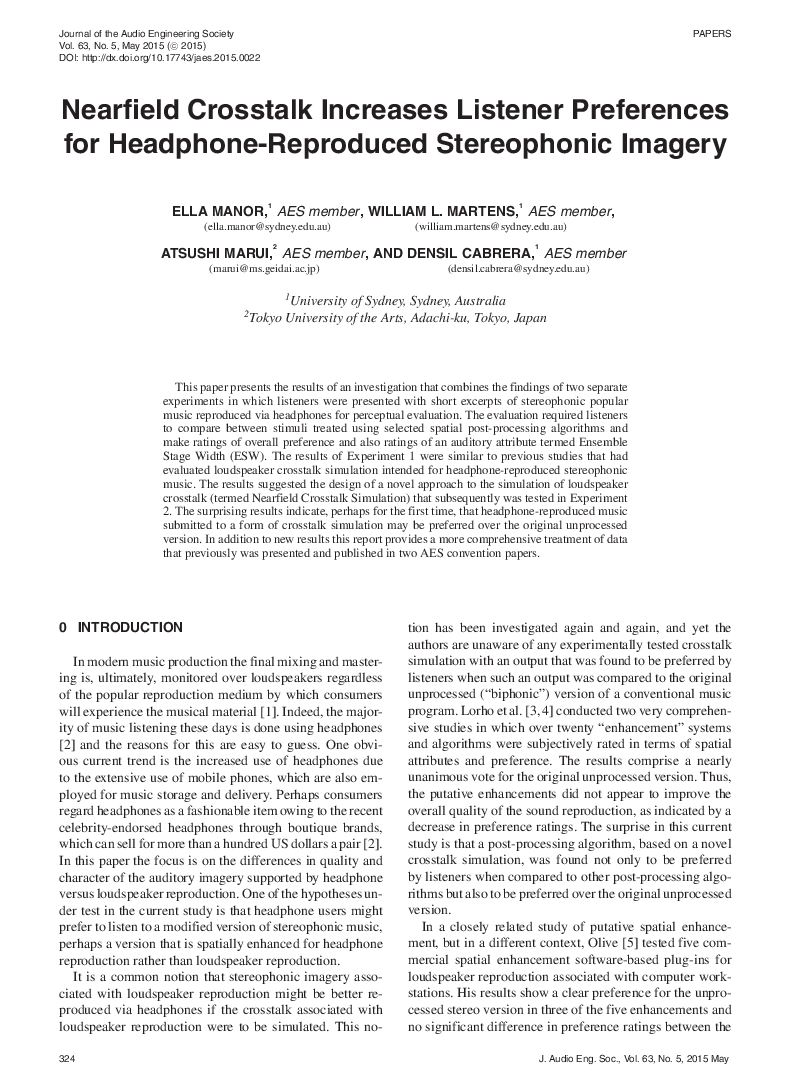Home / Publications / E-library page
You are currently logged in as an
Institutional Subscriber.
If you would like to logout,
please click on the button below.
Home / Publications / E-library page
Only AES members and Institutional Journal Subscribers can download
Although final mixing and mastering is monitored over loudspeakers, the majority of music listeners use headphones on mobile devices. Preferences for spatial process depend on the method of reproduction. For a variety of program material using headphones, listeners often prefer a stereophonic image that is created by simulating nearfield crosstalk compared to the biphonic spatial image. This novel approach, called Nearfield Crosstalk Simulation, describes crosstalk that simulates closely located loudspeakers. Previous work used farfield crosstalk simulation in an effort to produce an enhanced stereophonic effect, but such results were less preferred. The primary difference between the more conventional farfield crosstalk and the novel nearfield crosstalk developed for this study was the introduction of a level and a time difference at low frequency, consistent with what actually occurs for sound sources very close to a listener’s head.
Author (s): Manor, Ella; Martens, William; Marui, Atsushi; Cabrera, Densil
Affiliation:
University of Sydney, Sydney, Australia; Tokyo University of the Arts, Adachi-ku, Tokyo, Japan
(See document for exact affiliation information.)
Publication Date:
2015-05-06
Import into BibTeX
Permalink: https://aes2.org/publications/elibrary-page/?id=17638
(315KB)
Click to purchase paper as a non-member or login as an AES member. If your company or school subscribes to the E-Library then switch to the institutional version. If you are not an AES member Join the AES. If you need to check your member status, login to the Member Portal.

Manor, Ella; Martens, William; Marui, Atsushi; Cabrera, Densil; 2015; Nearfield Crosstalk Increases Listener Preferences for Headphone-Reproduced Stereophonic Imagery [PDF]; University of Sydney, Sydney, Australia; Tokyo University of the Arts, Adachi-ku, Tokyo, Japan; Paper ; Available from: https://aes2.org/publications/elibrary-page/?id=17638
Manor, Ella; Martens, William; Marui, Atsushi; Cabrera, Densil; Nearfield Crosstalk Increases Listener Preferences for Headphone-Reproduced Stereophonic Imagery [PDF]; University of Sydney, Sydney, Australia; Tokyo University of the Arts, Adachi-ku, Tokyo, Japan; Paper ; 2015 Available: https://aes2.org/publications/elibrary-page/?id=17638
@article{manor2015nearfield,
author={manor ella and martens william and marui atsushi and cabrera densil},
journal={journal of the audio engineering society},
title={nearfield crosstalk increases listener preferences for headphone-reproduced stereophonic imagery},
year={2015},
volume={63},
issue={5},
pages={324-335},
month={may},}